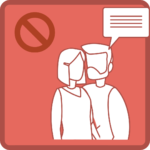Let’s talk about some ways to demonstrate your adoration for your loved ones. And, since our expertise is ears and hearing, we’re going to focus on how you can show some consideration while communicating with your honey who doesn’t hear well, even if they do not have hearing aids. In the two short minutes it takes to read to the bottom of the page, you can be become an expert on how to communicate with your loved one who has hearing loss. Oh, and these techniques can be used much more universally as well—whip these out anytime you want to be understood better by anyone, no matter their hearing level:
Don’t expect their devices to do all the work for you
As advanced as hearing instruments are, they still send the amplified signal through an impaired auditory system. Cochlear implants also have limitations. This isn’t a criticism of the hearing tech industry but praise of the human ear, the function of which science has yet to fully replicate.
Eliminate background noise during your conversation
This can be as simple as turning off the music or moving to a different, quieter room to continue your conversation; or as considerate as asking your hostess for a secluded corner booth in the restaurant. If you want to be really on your game, scout out a quieter venue ahead of time. You can scope it out in person or through other means (restaurant reviews, word of mouth recommendations, or an app such as SoundPrint, which crowdsources the task of finding less noisy locales).
Say my name, say my name
Ensure you actually have your partner’s attention before launching a conversation, otherwise it may become an unseen, unrequited monolog. Most people respond to their names even if you can’t sing it with Beyoncé’s butter-smooth voice. Wait for some acknowledgement of your bid for attention. Eye contact, verbal response and rude hand gestures all qualify (but if it’s the latter, you two have problems outside the scope of audiology). If your partner does not respond, there’s a good chance they didn’t hear you. Instead of yelling, consider moving closer (into the field of vision if you’re not there already). A gentle tap on the shoulder or arm can be considered appropriate depending on the nature of your relationship. Finger snaps, nose tweaks, pinches and loudly clearing your throat are undesirable ways to attract attention.
Don’t just talk louder or more clearly; slow down your rate of speech
We’re looking at you, Oregon; you fast talkers, you. Sad truth: some individuals with hearing loss have disproportionately poor word recognition abilities (sometimes referred to as “speech discrimination”). Additionally, some listeners (particularly older adults) may have poor temporal auditory processing abilities. Don’t worry about that definition so much as the implications: functionally, this means that for both groups, even when speech is loud enough, it still sounds garbled. Slowing your rate of speech can aid anyone regardless of their hearing abilities, but it will be especially beneficial to the listeners mentioned above.
Rephrase; don’t repeat
Sometimes a certain word can be hard to understand. Instead of saying the same thing repeatedly, flex your vocabulary skills and find a new way to express your thoughts.
Give an unobstructed view of your mouth
Viewing your lips and face can help tremendously in understanding. Your facial expressions and the movement of your mouth and lips are what professionals call, “visual cues.” Even people who have totally normal hearing or cannot lipread (“speech read” is the more accurate term) use visual cues continually to aid speech comprehension. Think about it: have you ever had a time in the past, oh say, two years during which someone’s face was covered and you had difficulty understanding them because of it? No? Here’s a teensy weensy hint.

Because they block the view of the lower face, masks prevent listeners from seeing visual cues that can help in understanding speech.
To that end, the following suggestions are geared for maximizing your partner’s view of your gorgeous visage:
Converse in the same room
For pete’s sake, stop trying to communicate by shouting through the house. Not only is it a terrible way to be understood, it’s just rude. Walk into the same room as Bae. This not only allows them to see your face (visual cues!), but improves the signal-to-noise ratio (which compares the level of your voice to the dishwasher/television/whiny kids).
Ensure good lighting
So your partner can see your face, obviously.
Communicate face-to-face
We’ll let these graphics speak for themselves.

This is an optimal way to converse.

Not ideal, but easily fixed. Rotate 180 degrees to make eye contact.

Save this distance for the people you want privy to your oral hygiene practices.

No. If astronauts in low gravity can make an effort to converse together in the same vertical orientation, so can you.
Don’t obstruct your mouth
Trim your facial hair, don’t cover your mouth with your hands and if you can converse in a setting where masks are not advised, great. If you’re really willing to go the extra mile, you can purchase a clear or windowed mask. You’ll turn heads and set safety fashion trends everywhere you go.
If read the whole list and you’re thinking, “None of these strategies are groundbreaking,” you’re right! Showing thoughtfulness in how you talk with others is simple. Even better, it costs nothing but pays big dividends to communicate in a way that your family and friends with hearing loss can understand. Don’t be surprised if you’re partner says “what” less often, your dialogues become more enjoyable, and you find yourself engaged in deeper, richer discussions.


